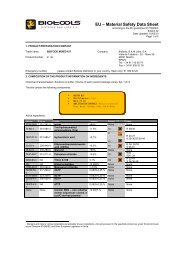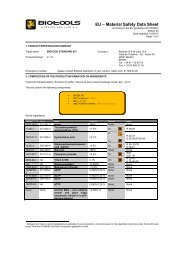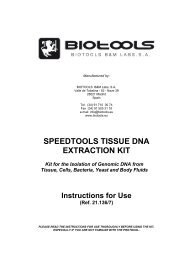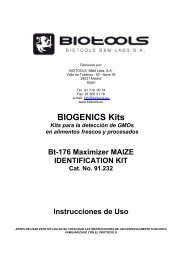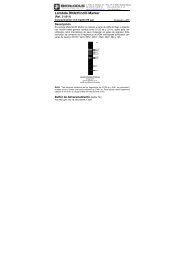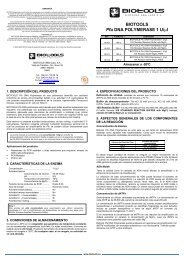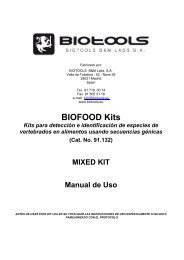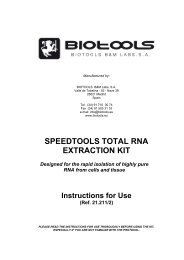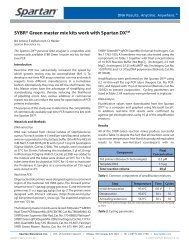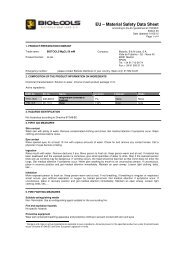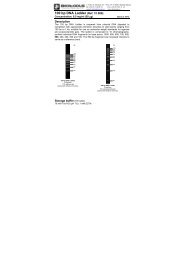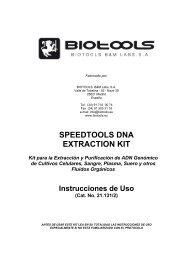BIOFOOD Kits - Biotools
BIOFOOD Kits - Biotools
BIOFOOD Kits - Biotools
Create successful ePaper yourself
Turn your PDF publications into a flip-book with our unique Google optimized e-Paper software.
Manufactured by:BIOTOOLS B&M Labs, S.A.Valle de Tobalina - 52 - Nave 3928021 MadridSpainTel. 91 710 00 74Fax 91 505 31 18e-mail: info@biotools.euwww.biotools.eu<strong>BIOFOOD</strong> <strong>Kits</strong><strong>Kits</strong> for vertebrate species detection and identification infood using genetic markers(Cat. No. 91.122)IDENTIFICATION KITPackage InsertPLEASE READ THE INSTRUCTIONS FOR USE THOROUGHLY BEFORE USING THE KIT, ESPECIALLY IF YOU ARENOT FAMILIAR WITH THE PROTOCOL.
GENERAL INFORMATION<strong>BIOFOOD</strong> kits allow the detection and, depending on the specific kit, the precise identification of a high number of animalspecies in food and feed samples, fresh and processed. The detection method is based on the stability of nucleic acids,that endure the processes used in food industry (temperature, vacuum, drying, etc.). The kit has been tested with fresh andhighly processed samples (including animal feed). DNA is purified from the samples, in order to be amplified and analysedby agarose gel electrophoresis.<strong>BIOFOOD</strong> IDENTIFICATION detects the presence of vertebrate material (mammal, reptile, bird, amphibian or fish 1 ) in asample by means of exponential amplification of a mitochondrial gene which is highly conserved throughout evolution(cytochrome b). This gene has been chosen due to its high cell copy number, as well as availability of sequences for a highnumber of species in databases. Amplified product is submitted to restriction analysis (RFLP), so that the species presentin the sample can be identified. This is possible due to minute differences in the sequence of the amplified fragment, sothat restriction patterns are species-specific.Unless otherwise indicated the Kit includes control DNAs from pork, turkey, chicken and goat. For other possible DNAcontrols contact our Technical Dept. (info@biotools.eu).RESEARCH USE ONLYSome of the applications which may be performed with this product may be covered by applicable patents in certain countries. Thepurchase of this product does not include or provide a license to perform patented applications. Users may be required to obtain a licensedepending on the country and/or application. <strong>Biotools</strong> does not encourage the unlicensed use of patented applications.PLEASE CHECK KIT AND REAGENTS INTEGRITY BEFORE USE. USE OF DETERIORATED KITS MAY CAUSELACK OF RESULTS AND/OR EQUIVOCAL RESULTS.PRINCIPLEDNA is obtained either from fresh or processed samples using an optimised method 2 (we recommend using Genomic DNAExtraction Kit - Cat. No. 21.002, 24 tests, or 21.003, 48 tests, available in our catalogue). Use of other methods is possible.However, user must confirm that the purified DNA can be used with the kit (concentration 50-100 ng / µl, A 260/280 =1.8 – 2.0,absence of inhibitors that may affect the result of the amplification reaction, etc.). It is recommended to check the qualityand suitability of the purified DNA for amplification reactions, e.g., performing control amplifications in parallel.<strong>BIOFOOD</strong> IDENTIFICATION kit is based on the detection and amplification of cytochrome b from vertebrates, followed byrestriction analysis in order to obtain species-specific restriction patterns, which are analysed by agarose gelelectrophoresis.<strong>BIOFOOD</strong> IDENTIFICATION kit can be used with heterogeneous samples (more than one component). However,presence of 3-5 species in a sample may cause difficulties in interpreting the restriction patterns. Sensitivity of the kitranges between 0.5 – 5 %, depending on the identity of the species present in the sample and their relative percentage.REAGENTSThe Kit contains reagents in liquid format for performance of 48 amplification reactions (Cat. No. 91.122). To minimizethe risk of contamination and facilitate the use of the Kit several times the Kit is presented in two set of 24reactions. Sample Kit (Cat. No. 91.121) contains one set of 24 reactions. Thaw and handle reagents on ice. Do notfreeze/thaw Kit vials repeatedly. In case of frequent use, we recommend the aliquoting of the vial contents.• Master Mix Two vials: 2 x 405 µlA Tris-HCl solution, containing
• Enzyme 1 Buffer Two vials: 2 x 54 µl10X buffer for Enzyme 1.Store at –15±8 ºC.• Enzyme 2 Two vials: 2 x 14 µlStore at –15±8 ºC.• Enzyme 2 Buffer Two vials: 2 x 54 µl10X buffer for Enzyme 2Store at –15±8 ºC.• Enzyme 3 Two vials: 2 x 14 µlStore at –15±8 ºC.• Enzyme 3 Buffer10X buffer for Enzyme 3 Two vials: 2 x 54 µlStore at –15±8 ºC.• Amplification Controls (Positive Controls)DNA amplification products at 10 6 copies/µl from 4 different origins. Unless otherwise indicated the kit includedcontrols are:Pork Amplification Control Two vials: 2 x 40 µlTurkey Amplification control Two vials: 2 x 40 µlChicken Amplification Control Two vials: 2 x 40 µlGoat Amplification Control Two vials: 2 x 40 µlStore at –15±8 ºC. Thaw and handle on ice. Do not freeze/thaw repeatedly. For frequent use, we recommend thealiquoting of the vial contents.Available control DNAs in <strong>Biotools</strong>’ catalogue are 3 *:* Cow * Dog * Sheep* Horse * Cat * Rabbit* Human * Duck * GooseMATERIALS REQUIRED BUT NOT PROVIDEDNOTEFor all equipments, regular maintenance and calibration is necessary. Follow manufacturer’s instructions, and check workingparameters regularly, specially for thermal cyclers and pipettes. Maintenance and calibration of instruments allows its correctfunctioning, and helps detecting problems that may render an incorrect analysis result.Pre-amplification area• Equipment, reagents and disposable material necessary for DNA purification (depending on the method, follow manufacturer’sinstructions)• Timer• Automatic pipettes 4 (10, 20 and 200 µl), filter or positive displacement tips, RNase-free 5• Disposable examination gloves, powder-free• Sterile bidistilled water• Screw cap polypropylene tubes, 1.5 ml capacity, non siliconised, conical, sterile, RNase-free. It is recommended to use screwcap tubes, in order to avoid the potential contamination of samples and controls.• Racks for 1.5 ml vials• Containers for disposal of potentially-infectious material• Disposable filter paper for working surface, cleaning paper for accidental spills• Termi-DNA-Tor 6 or equivalent, in order to remove DNA from working surfaces3 The list of available control DNAs is continuously growing. Should you be interested in a particular bird or mammalian species notincluded in this list, please do not hesitate to contact us for further information.4Precision of automatic pipettes must be in the range of 3 % of the indicated volume. If necessary, calibrate and check regularly, followingmanufacturer’s instructions. It is recommended to use RNase-free filter tips and positive displacement tips, in order to avoid crosscontamination between samples and amplicons.5It is recommended to use different sets of pipettes for each reaction step (pre-amplification, amplification, post-amplification), in order toavoid contaminations that may render false positive results.6Available in <strong>Biotools</strong>’ catalogue (Cat. No. 40.201).Ed. 13 – December 08Page 2 of 6
Amplification area• Thermal cycler: Eppendorf MasterCycler Personal, MJ Research MiniCycler or Applied Biosystems GeneAmp2700. Use of this kit in other equipments has not been tested. For further information, contact our Technical Dept.(info@biotools.eu).• Laminar flow cabinet• Racks for reaction vials• Reaction vials (0.2 ml, thin-walled)• Sterile bidistilled water (Cat. No. 20.033 or equivalent)• Automatic pipettes (10, 20 and 200 µl), filter or positive displacement tips, RNase-free• Disposable examination gloves, powder-free• Containers for disposal of potentially-infectious material• Disposable filter paper for working surface, cleaning paper for accidental spills• Termi-DNA-Tor or equivalent, in order to remove DNA from working surfacesPost-amplification area• Electrophoresis power supplies and tanks• Gel Documentation system• UV transilluminator• Ethidium bromide• Low EEO agarose (Cat. No. 20.011) or equivalent• TAE or TBE• DNA Ladder ranging between 150 to 700 bp (Cat. No. 31.006) or equivalent• Electrophoresis loading buffer• Automatic pipettes (10, 20 and 200 µl), filter or positive displacement tips, RNase-free• Disposable examination gloves, powder-free• Protective mask / goggles for UV• MicrowavePROTOCOLNOTEThaw all reagents on ice. Keep on ice while in use. Amplification must be started in the next 10 minutes after adding the purifiedDNA and controls to the amplification mix. Check thermal cycler regularly. Non-existent or poor calibration of the equipment mayrender equivocal results. Este protocolo ha sido adaptado para equipos de amplificación Eppendorf, MJ Research y AppliedBiosystems GeneAmp.This protocol has been adapted for Eppendorf, MJ Research and Applied Biosystems GeneAmp thermal cyclers. For otherthermal cyclers, optimisation of reaction parameters may be necessary. For any question, please contact our Technical Dept.(info@biotools.eu).1.- Final reaction volume is 50 µl. Calculate the necessary volume of the Master Mix, MgCl 2 , DNA Polymerase andPositive Control for the analysis of samples and controls. It is recommended to perform one Positive Control and oneNegative Control in each round of analysis (this must be taken into account when calculating necessary volume forperformance of all reactions).2.- Mix the necessary volume of Master Mix, MgCl 2 and DNA Polymerase for the number of reactions to perform in a1.5 ml vial. Perform this process in a laminar flow cabinet. Keep the reaction mixture (reaction mixture = Master Mix+ MgCl 2 + DNA Polymerase + sterile bidistilled water) on ice:For 3 reactions For 10 reactions For n reactionsReagentMaster Mix 45 µl 150 µl 15 * n µlMgCl 2 6 µl 20 µl 2 * n µlDNA Polymerase 3 µl 10 µl 1 * n µl3.- Aliquot 40 µl of the reaction mixture in each amplification vial, in the laminar flow cabinet.4.- Remove vials from laminar flow cabinet. Add 50-100 ng from DNA from the purified samples and/or controls to eachamplification vial. Complete up to 50 µl final volume.NOTEFor control reactions, use 5 µl of Positive Control (except cat and dog, where 20 µl should be added). For negative controls,use 5 µl of sterile bidistilled water.Ed. 13 – December 08Page 3 of 6
5.- Close amplification vials. Place them in thermal cycler. Store remaining of all reagents at temperatures under –18 ºC.Perform the amplification according to the following program:94 ºC 1 min 30 sec94 ºC 10 sec55 ºC 30 sec 35 cycles72 ºC 40 sec72 ºC 3 min4 ºC ∞6.- After amplification, result can be checked by 1 % agarose gel electrophoresis. A 359 bp band must be obtained forsamples positive to vertebrate material. Store amplification product at 2-8 ºC, unless restriction analysis is to be performedin the next 1-2 hours.7.- Transfer 10 µl of amplification product to a new vial, and add 7.5 µl of sterile bidistilled water.8.- Add 2 µl of the corresponding 10X buffer (1, 2 or 3)9.- Add 0.5 µl of the corresponding restriction enzyme (1, 2 or 3)10.- Incubate 2 hours at 37 ºC. For optimal results, incubate for 3 hours.INTERPRETATION OF RESULTSThe analysis of amplification products is performed by horizontal electrophoresis in low EEO-agarose gels (e.g. MBAgarose, Cat. No. 20.011). Band visualisation is improved in 1 % gels using TAE 1X or TBE 0.5X as running buffers. It isrecommended to add ethidium bromide in the agarose gel for a better resolution and visualisation. For restriction patternanalysis, use 2-3 % gels using TAE 1X or TBE 0.5X as running buffers. It is recommended to add ethidium bromide in theagarose gel for a better resolution and visualisation.NOTEEthidium bromide is a highly mutagenic intercalating agent. Use of gloves and maximum caution is recommended on handlingthis reagent.Samples containing vertebrate sequences will render a band of 359 bp. Compare RFLP patterns with the table as well asFigure 1.Species Enzyme 1 Enzyme 2 Enzyme 3 Species Enzyme 1 Enzyme 2 Enzyme 3Cow 28673Pork 153127736Chicken 15912773Turkey 1271037356Sheep 15912773Goat 2307356Cat 253732211359 19811744Duck* 28673359 359 Horse 159105732221114814811010118816110198161359 29663359 19816121312224117 (x2)8144Dog 232127Rabbit 1531334330Human 23210522Goose* 15313373-- 359359 23481442834234296549359 233126359 198161-- 359* Restriction patterns for these species have been deducted from agarose gels, as there is no accurate information in databases. Patterncorresponding to Enzyme 2 has not been clearly assigned.Ed. 13 – December 08Page 4 of 6
NOTEDue to sequence differences between samples of different brew or geographical origin, some restriction patterns may vary fromthose indicated in the table. Please contact our Technical Dept. for further information.M 1 2 3 4 5 6 7 8 9 10 11 12 13 14MFigure 1: Visualisation of RFLP fragments belonging to 14 different species afterdigestion with restriction endonuclease 1 included in this kit. M: 100-bpmolecular ladder (Cat. No. 31.006). Lanes 1 to 14: restriction profiles from waterbuffalo, rabbit, horse, roe deer, cow, goat, deer, emu, red kangaroo, ostrich, cat,dog, mouse and human.QUALITY CONTROLIt is recommended that at least one (1) Positive Control and one (1) Negative Control be run each time the test isperformed. As with any new laboratory procedure, novel users should consider performing additional controls (both positiveand negative) until a high degree of confidence is reached.The Positive Control must render the corresponding bands (see ‘Interpretation of Results’). Vials containing negativecontrol (sterile bidistilled water) must render no bands. Any analysis not fulfilling any of these results must be completelyinvalidated and discarded. It is necessary to repeat the process from its beginning, including DNA purification, processingother aliquot of the original sample. A failure of instruments during the test, indicated by error messages, also means thatthe test has not been valid. Repeat all the procedure for each sample from the amplification step.PROCEDURAL PRECAUTIONS1. Laboratory workflow must be unidirectional, from pre-amplification area to post-amplification area. Pre-amplification tasks mustbe initiated with the preparation of the reagents and sample purification. Equipments, materials and reagents must be dedicatedand they must not be used for other activities or be transferred from one to another area. Gloves must be worn in each area,and must be discarded before proceeding to the next area. Equipments and materials used for setting-up of reactions must notbe used for other activities, or for pipetting or processing amplified DNA or other DNA sources.2. As with any analytical procedure, it is fundamental to use a good laboratory practice to obtain good results with this technique.Due to the high analytical sensitivity of the test, extreme care must be taken in order to keep the purity of all kit reagents and allreaction mixes. All reagents must be carefully checked in order to ascertain their purity. Discard all suspect reagents.3. Instructions must be followed in order to obtain correct results. Should the user have any questions, please contact ourTechnical Dept. (info@biotools.eu)4. This test has been validated for use with the reagents provided by the kit. The use of other amplification methods, or the use ofequipment not fulfilling the specifications, may render equivocal results. User is responsible for validating the modifications forthis test, in any of the indicated parameters.5. Use powder-free examination gloves while handling reagents or samples, as well as lab coat. Wash hands thoroughly afterperforming the test.6. Open and close reagent vials carefully. Observe temperature and light exposure instructions. After use, close vials and store atindicated temperatures.7. Do not use product after expiry or best before date.8. Kit components have been tested as a whole. Do not interchange components with other kits, or components from differentlots9. Nucleic acids are very sensitive to degradation by nucleases. Nucleases are present in human skin and surfaces that have beenin contact with humans. Wash with Termi-DNA-Tor and cover working surfaces with suitable paper. Use powder-freeexamination gloves throughout the whole process10. Extreme care must be taken when aliquoting the different volumes in each reaction step. Mix well after addition of each reagent,unless otherwise noted. Read instructions for use of automatic pipettes11. Do not pipette by mouthEd. 13 – December 08Page 5 of 6
12. Packaging material included with the kit is resistant to the indicated storage conditions. Storage at different conditions cancause breakage of the material, and possible contamination of kit contents13. Plastic material included with the kit is resistant in the normal conditions of use. Use of plastic material in extreme conditionsmay cause its breakage, and therefore, impossibility to use the kit14. False negative results may be obtained due to polymerase inhibition. It is recommended to perform control reactions todistinguish between inhibition and true negatives.15. Cross contamination between samples and exogenous DNA can only be avoided by following good laboratory practice.Instructions in this document must be strictly followed.16. Use of this product is limited to qualified professional personnel, experienced in DNA purification and DNA amplificationtechniques.17. It is important to pipet the indicated amounts, and mix well after each reagent addition. Check pipettes regularly.WARRANTYProducts are guaranteed to conform to the quality and content indicated on each vial and external labels during their shelf life. BIOTOOLS obligation andpurchaser’s rights under this warranty are limited to the replacement by BIOTOOLS of any product that is shown defective in fabrication, and that must bereturned to BIOTOOLS, freight prepaid, or at BIOTOOLS’ option, replacement of the purchasing price.Any complaint on damaged goods during transport must be directed to the handling or transport agent.Product for Research Use Only. This product must be used by qualified professionals only. It is the responsibility of the user to ascertain that a given productis adequate for a given application. Any product not fulfilling the specifications included in the product sheet will be replaced. This warranty limits ourresponsibility to the replacement of the product. No other warranties, of any kind, express or implied, including, without limitation, implicit warranties ofcommercialisation ability or adequacy for a given purpose, are provided by BIOTOOLS. BIOTOOLS will not be held responsible for any direct, indirect,consequential or incidental damage resulting of the use, misuses, results of the use or inability to use any product.Manufactured by:BIOTOOLS, Biotechnological & Medical Laboratories, S.A. has been evaluated and certified to accomplish ISO 9001:2000 requirements for the followingactivities: Research and development of biotechnology products and manufacture of biotechnology and in vitro products.Valle de Tobalina – 52 – Nave 39, 28021 Madrid – SpainBIOTOOLS® is a registered mark of BIOTOOLS, Biotechnological & Medical Laboratories, S.A.Ed. 13 – December 08Page 6 of 6




